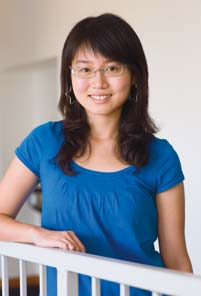The following is the first in a series of profiles of our MIT Energy Fellows—graduate students who are supported by MIT Energy Initiative (MITEI) members to participate in faculty-led research and become part of a long-term community of students and alumni. More information is at MITEI Energy Fellowships.

Walk into a Circuit City or an Apple store, and you’ll walk out with more computing power than NASA used to put men on the moon. Bonnie Lam believes that reducing the energy used by megapowerful computers’ tiniest components will cut their astronomical energy use down to size.
“Computers and electronics currently out there are sucking up a lot of energy. Everyone uses these components. Engineering provides the tools to jump in there and help people save energy in a way more substantial than allowed by current technology,” Lam said.
Lam joins MIT this September as one of 39 MIT Energy Fellows. This inaugural, multidisciplinary group of doctoral students, sponsored by MITEI member companies, shares an interest in addressing the science, technology, and policy required to meet the global energy challenge and associated environmental issues.
Lam, sponsored by Eni at MIT, moved from fast-paced, high-pressure Hong Kong to Vancouver, Canada, with her family when she was 10. She said the laid-back, creative focus of Canadian schools allowed her to be a kid, join a Brownie troop, and find her own academic path.
That path led her to the engineering physics program at the University of British Columbia, where she took “a lot of physics and math” and became interested in low-power digital circuits. At MIT, Lam will work on sub-threshold circuits, which feature a power supply voltage below the device threshold voltage. Systems incorporating these energy-friendly components can be operated at reduced performance levels to lengthen their battery lifetimes. More and more designers are incorporating sub-threshold approaches in cutting-edge ultralow-power devices.
Joining Anantha P. Chandrakasan, director of the Microsystems Technology Laboratories (MTL) and professor of electrical engineering and computer science, and seven other graduate students in the Sub-Threshold Circuits Group at MIT, Lam’s future could involve analyzing the optimal energy point of a given system, modeling energy characteristics of sub-threshold circuits, or developing circuit styles for logic and memory elements that operate at ultra-low voltages.
A course she took at UBC made her aware of “the increasing significance of energy as process technology continues to reduce in size,” she said. “To me, it’s a very fundamental idea that it’s important to lower the operating voltage on chips.”
Lam knew she wanted to continue her academic career outside of Canada after her undergraduate degree. Both Stanford and MIT appealed to her, but it was an exploratory visit to MIT that won her over to the East Coast. She liked the fact that the Master’s/PhD program incorporated a lot of research with the coursework.
“Everyone in the group was really friendly and MIT seemed like a nice place to be,” she said. “It will all be a fresh experience for me, especially since my background is not in traditional electrical engineering. It will be a very new experience—moving into a new field and a new place.”
Lam is no stranger to new locales. She studies Cantonese and Mandarin in Vancouver, staying fluent and in touch with her heritage through regular visits to Hong Kong. She is struck by the contrast between Hong Kong’s frenetic pace and high-rises and her wood-framed white house in Canada. At home, barbecues are held in the backyard, not in public parks like in Hong Kong.
“Whenever I come to visit in Hong Kong, I notice that everyone moves more quickly than in Canada,” she said. On a recent visit, she avidly followed the Beijing Olympic Games, both through watching live television programs and attending a Hong Kong Equestrian event. She is impressed by the efforts made by Beijing and other host cities to address environmental issues in preparation for the Olympics, particularly by the energy-saving design of the Beijing National Aquatic Centre known as the Water Cube.
Lam is excited about the opportunity afforded by the MITEI Fellowship. “My view is that it’s very important for everyone to become aware of how to save energy. Everyone knows how to turn off the lights when they leave the house, but technology can do more in the background to save energy. Figuring out how to save energy while a computer is running—that’s something only an engineer can do,” she said. “That’s my calling.”